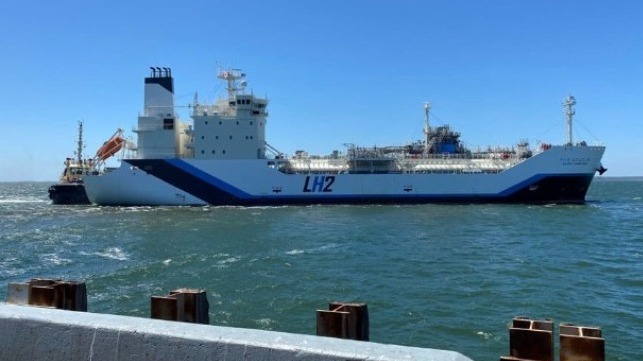Failed Solenoid Caused Burst of Flame on Hydrogen Tanker's Foredeck

The failure of an under-designed electrical solenoid valve caused a burst of flame from a vent stack aboard the liquid hydrogen carrier Suiso Frontier last year, according to the Australian Transport Safety Bureau.
Suiso Frontier is the first vessel of her kind, and her development is a key step towards the long-distance transportation of hydrogen gas. On her maiden voyage in January 2022, Suiso Frontier transited from Kobe, Japan to the port of Hastings, Australia, arriving January 20. As part of a pilot program, she took on a small cargo of hydrogen extracted from brown coal, and she completed cargo operations on January 24.
On January 25, before her scheduled departure, the ship's chief mate and cargo engineer prepared to burn off excess boil-off gas from the ship's liquid hydrogen cargo tank. Like LNG, LH2 is a cryogenic liquid, and part of the cargo turns back into gas over time as ambient heat warms the tank. To control the tank pressure, the gas is periodically burned off.
Following standard procedures, they notified the terminal operator and prepared the vessel's gas combustion unit for use. This automated burner system began its own startup checks at 1947 hours, and it began operating at 2007.
The cargo engineer gradually raised the flow rate to the combustion unit to the maximum of 40 kilos per hour, and all operating parameters looked normal. The third mate came on watch and took over monitoring from the ship's cargo control room.
At 2147, an AB on the ship's deck saw a yellow flame about three feet high come out of the GCU's vent stack on the port side of the foredeck. He called the third mate to warn him. Just a few seconds later, the flue gas temperature from the GCU hit more than 800 degrees F, setting off high-temp alarms in the control room. The third mate shut down the GCU, closed off its hydrogen supply valve and confirmed with the AB that the flame was gone. He then notified the chief mate, master and cargo engineer.
Following procedure, the master sounded the fire alarm and mustered the crew for firefighting duties. Meanwhile, the chief mate headed out on deck with the cargo engineer to inspect the GCU and its vent stack. There were no obvious signs of fire, though the unit's vent was abnormally hot. An after-incident shipboard examination of the GCU revealed no serious damage.
A more detailed inspection, however, revealed that a solenoid valve for an air damper actuator had failed, causing the damper to close. This cut off the unit's air supply for cooling and dilution, causing the flue gas temperature to spike.
The GCU was made by a reputable manufacturer of combustion units for LNG carriers and other marine applications, and it had already been used for hundreds of hours. On inspection, the OEM found that it had specified a 24 volt DC solenoid for a system that operates on 230 volt AC. A DC solenoid is not designed to withstand AC operation, nor voltages 10 times higher than rated, and the unit eventually failed. The valve shut, the damper closed, and the system's safety sensors were not set up to detect the fault.
“The ATSB’s investigation highlights the importance of ensuring automated shipboard operating systems are equipped with safety controls to prevent hazardous consequences in the event of a malfunction,” ATSB Chief Commissioner Angus Mitchell said. “The incident also shows the importance of stringent manufacturer quality controls to ensure correct system components are specified and fitted to equipment.”
The faults were corrected by the OEM, and the Suiso Frontier returned to service. Her operator is planning to integrate lessons-learned into a larger vessel capable of carrying 20,000 cubic meters of LH2, and it has contracted with a different OEM for the design of a new gas combustion unit for hydrogen boil-off gas.
